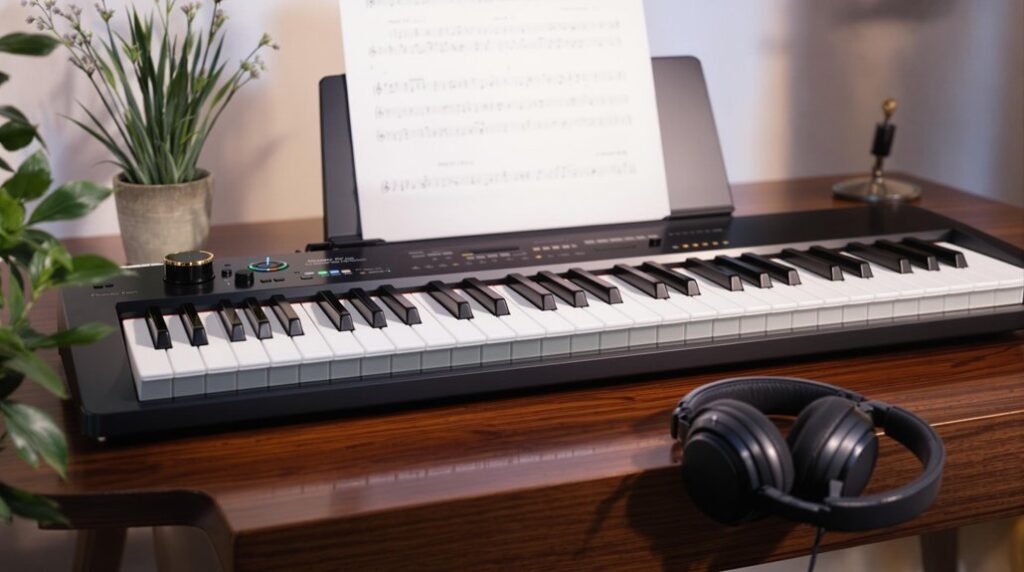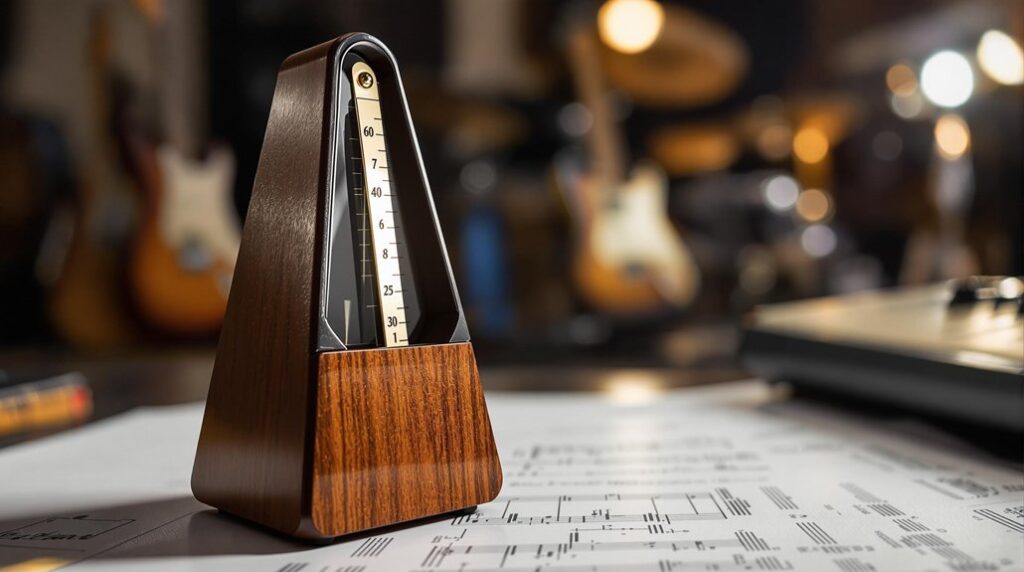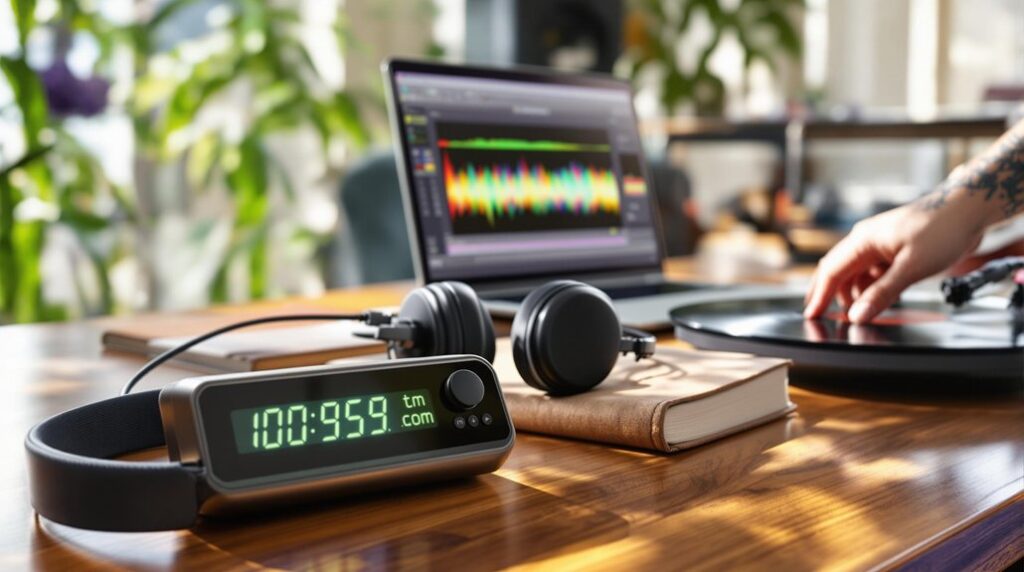Mastering eighth notes is crucial to enhancing your musical performance. Eighth notes, representing half a beat, require you to divide each beat into two equal parts. Using a metronome helps you maintain a steady rhythm. Practice counting out loud: ‘1 and, 2 and, 3 and, 4 and’. Accent the offbeats to refine your timing and add dynamic variation. Incorporate eighth rests to balance sound and silence. Try exercises mixing eighth and quarter notes to develop fluidity. By focusing on these techniques, you’ll bring greater precision and energy to your music, revealing more advanced rhythmic possibilities. Keep exploring for further insights!
Key Takeaways
- Eighth notes represent half a beat, and counting ‘1 and, 2 and, 3 and, 4 and’ helps in precise timing.
- Visual aids like charts and diagrams can help in understanding the structure of eighth notes connected by beams.
- Practicing with a metronome ensures steady timing and helps internalize the even subdivision of beats.
- Clapping or tapping exercises can improve rhythm accuracy and synchronization of downbeats and upbeats.
- Combining eighth notes with quarter notes in practice enhances rhythmic balance and fluidity in playing.
Historical Background
The term ‘eighth note‘ has its origins in the Renaissance period, where it emerged as an essential element in written music. During this time, the symbol for the eighth note began to take shape, resembling a crotchet but with an additional flag or beam. This period marked a significant evolution in musical notation, laying the groundwork for the complex rhythmic patterns we use today.
You might find it fascinating that the Renaissance origins of the eighth note contributed to a broader musical evolution. As composers and musicians sought more precise ways to capture the nuances of their compositions, the eighth note became a vital tool. It allowed for greater rhythmic variety and intricacy, making music more expressive and dynamic.
Understanding Eighth Notes
When you read and play eighth notes, you’re dealing with rhythmic symbols that represent half a beat each.
Understanding the downbeat and upbeat is important; you’ll count them as ‘one-and, two-and’ to maintain an even rhythm.
This even division of beats is key to achieving precise timing and rhythmic variation in your music.
Eighth Note Basics
To grasp the essence of eighth notes, start by recognizing that they split each beat into two equal parts, effectively doubling the rhythm’s pace. This means that for each quarter note, you can play two eighth notes, counted as ‘1 and’, ‘2 and’, and so on.
When you practice rhythmic subdivisions, it’s important to use a metronome. This tool helps you keep a steady beat and confirms that your eighth notes are evenly spaced. Set your metronome to a comfortable tempo and listen carefully to the clicks as you play. Each click represents a beat, and you’ll fit two eighth notes within each beat. This disciplined practice will refine your sense of timing.
Eighth notes also play a significant role in creating syncopation, where the emphasis is shifted from the strong beats to the weaker ones, adding complexity and interest to your musical phrasing.
Downbeat and Upbeat
Understanding how to distinguish between the downbeat and the upbeat in eighth notes will further refine your rhythmic accuracy and musical expression.
The downbeat is the first eighth note of a beat, providing a sense of stability and grounding. By accenting downbeats, you can emphasize the fundamental pulse of the music, creating a solid rhythmic foundation.
The upbeat, or the ‘and’ of the beat, is equally important. It introduces rhythmic variations and adds dynamic contrast. When you explore syncopation, you’re deliberately placing emphasis on these offbeats, which can make your music feel more energetic and unexpected. Syncopation often involves playing or accenting the upbeat, creating a sense of rhythmic tension and release.
To master this, practice clapping or tapping along to a metronome, emphasizing the downbeats and feeling the lift of the upbeats. This physical engagement helps internalize the difference between the two.
Additionally, try incorporating eighth rests in your practice. Recognizing silence on either the downbeat or upbeat reinforces your understanding of their placement and importance.
Counting Evenly
Counting evenly is crucial for mastering eighth notes and ensuring your rhythmic timing is spot on. Each eighth note represents half a beat, so you need to divide each beat into two equal parts. This division is important for maintaining rhythmic accuracy and tempo control in your playing.
To get started, count each beat as ‘1 and, 2 and, 3 and, 4 and,’ with the numbers representing the downbeats and the ‘and’ representing the upbeats.
When you practice this counting method, you’ll improve your musical timing and rhythmic precision. Begin by clapping your hands or tapping your foot to a steady beat, then add the ‘and’ between each clap or tap. This helps you internalize the even subdivision of beats, ensuring that each eighth note gets its proper duration.
Using a metronome can further enhance your tempo control. Set it to a comfortable tempo and practice counting aloud along with it. Gradually increase the tempo as you become more confident.
Counting Eighth Notes
When tallying eighth notes, you’ll accentuate the downbeat with a strong ‘1’ and follow it with a lighter ‘and’ to maintain a precise rhythm. This method helps you navigate rhythmic challenges and secures accurate musical timing.
Each beat is divided into two equal parts, with the first note landing on the downbeat and the second on the upbeat. Counting out loud as ‘1 and 2 and 3 and 4 and’ secures that you keep an even pace and accurately subdivide each beat.
Maintaining tempo control is vital when dealing with eighth notes. Keeping a steady pace allows you to execute syncopation techniques effectively, where the emphasis shifts to off-beats, creating more complex rhythmic patterns.
By practicing counting eighth notes, you gain better control over your timing and can tackle more intricate rhythms with confidence.
It’s essential to practice counting eighth notes slowly at first, gradually increasing the tempo as you become more comfortable. This approach helps you internalize the rhythm and secures that you can play accurately, even at faster speeds.
Proper counting of eighth notes builds a strong rhythmic foundation, enabling you to handle any musical piece’s rhythmic demands with ease.
Eighth Note Examples
To get the hang of eighth notes, you’ll start by counting them accurately, then practice various eighth note patterns to build your rhythm skills.
We’ll go through some simple exercises to help you become comfortable reading and playing these notes.
Counting Eighth Notes
Mastering the rhythm of eighth notes requires you to think of each beat as being split into two equal parts, creating a lively and engaging pace. To count eighth notes accurately, you must envision each beat as ‘1-and, 2-and, 3-and, 4-and.’ This method guarantees that you play each note evenly, maintaining rhythmic precision.
Using a metronome during practice is essential for honing this skill. The metronome’s steady beat helps you internalize the timing, making your shifts between the downbeat and upbeat smooth and precise. It’s also vital for mastering syncopation and enhancing your musical phrasing.
To help visualize and practice counting eighth notes, imagine the following scenarios:
- A drummer tapping the hi-hat on every ‘and’.
- A pianist playing alternating left and right hand notes on each beat and ‘and’.
- A guitarist strumming down on the beat and up on the ‘and’.
- A violinist alternating bow strokes with each eighth note.
- A singer tapping their foot to maintain the beat while singing each ‘and’.
Eighth Note Patterns
Eighth note patterns, such as alternating single notes and paired notes, can add dynamic energy and complexity to your music. By mastering various rhythmic combinations, you’ll enhance your playing techniques and bring more life to your performances.
Start by practicing simple patterns, like a sequence of paired eighth notes, often notated with a beam connecting them. This creates a smooth, flowing rhythm that can be applied across different musical contexts.
To dive deeper, try mixing single and paired notes. For instance, play a single eighth note followed by a pair, and then another single note. This not only challenges your timing but also introduces subtle syncopation, making your music more engaging.
When you’re comfortable with these patterns, experiment with improvisation ideas. Use eighth notes to create spontaneous melodies or rhythmic motifs. You can even incorporate them into your solos, adding flair and complexity.
For performance tips, always maintain a steady tempo and use a metronome to keep your timing sharp. Pay attention to how eighth notes fit within the larger phrase, ensuring each note is precise and well-articulated.
With consistent practice, these eighth note patterns will become a natural part of your musical vocabulary.
Eighth Note Exercises
Immerse yourself in eighth note exercises to refine your sense of timing and rhythmic precision. These exercises are essential for mastering the rhythm of two equal halves in a beat. By practicing eighth notes, you’ll enhance both your rhythmic accuracy and musical precision, making your playing more fluent and precise.
To get started, incorporate these exercises into your practice routine:
- Single Beat Subdivision: Play a steady quarter note pulse and subdivide each beat into two eighth notes.
- Mixed Note Values: Combine eighth notes with quarter notes, half notes, and whole notes to practice shifting between different rhythms.
- Accent Shifts: Practice placing accents on different eighth notes within a measure to develop control and dynamic variation.
- Syncopation Drills: Use syncopated patterns to challenge your internal timing and improve your ability to stay steady.
- Metronome Practice: Set a metronome to a slow tempo and gradually increase the speed as your comfort with eighth notes improves.
These exercises help reinforce the concept of rhythmic subdivision, essential for mastering fluency in music. By consistently practicing these patterns, you’ll not only gain better control over eighth notes but also build a solid foundation for more complex rhythms.
Eighth Rests Explained
You’ll find that an eighth rest, which represents silence for half a beat, is important for mastering rhythm and timing in music. Recognizing its rhythmic significance helps you maintain the balance between sound and silence, essential for musical interpretation. Eighth rests can occur on the downbeat or upbeat, providing a brief pause that shapes the flow of a piece.
Understanding rest durations is essential to your musical toolkit. The silence significance of an eighth rest can’t be overstated. It allows for breath, space, and contrast within the music, making each note that follows more impactful. Properly incorporating these rests guarantees your performance is dynamic and expressive.
When you see an eighth rest in your sheet music, remember it holds the same time value as an eighth note but signifies a moment of silence. This rest duration helps you accurately execute timing and rhythm, preventing the music from sounding rushed or muddled. By giving attention to these rests, you’ll bring depth and nuance to your playing, enhancing the overall musical experience.
Incorporate eighth rests with care, and you’ll find your performances becoming more sophisticated and engaging. Mastering these pauses is just as vital as playing the notes themselves.
Combining Eighth and Quarter Notes
While mastering eighth rests enhances your musical expression, combining eighth and quarter notes introduces a dynamic layer to your rhythmic toolkit. This combination adds complexity and excitement to your music, allowing you to create syncopated rhythms and explore creative combinations.
When you play patterns that alternate between eighth and quarter notes, you’ll notice how eighth notes inject a sense of movement and energy. Quarter notes, on the other hand, provide stability, aligning with the downbeats to maintain a steady rhythm. By mastering this coordination, you enhance your musical phrasing and dynamics.
Consider these visualizations to improve your understanding:
- A flowing melody: Eighth notes create a seamless connection between the steady beats of quarter notes.
- Energetic bursts: Quick eighth notes interspersed with quarter notes add lively accents.
- Rhythmic balance: The alternation adds a balanced feel to your playing, blending motion with stability.
- Improvisation techniques: Use these patterns in your solos to add rhythmic variations and keep listeners engaged.
- Syncopated rhythms: Experiment with off-beat eighth notes to introduce unexpected twists in your music.
Advanced Rhythms
Delving into advanced rhythms, you’ll encounter intricate patterns like sixteenth notes that challenge and expand your rhythmic skills. Sixteenth notes, which divide each beat into four equal parts, can turn a simple measure into a dynamic and complex rhythm. You’ll need to master these subdivisions to enhance your musical comprehension and fluency.
One advanced technique to explore is syncopated rhythms, where the emphasis falls on the off-beats or unexpected parts of the measure. Syncopation adds a layer of complexity and excitement to your music, making it more engaging for listeners.
As you dive deeper, practice improvising with eighth notes. This exercise helps you develop a keen sense of timing and adaptability, essential for handling complex rhythms.
Understanding different note values is essential. Sixteenth notes aren’t just faster; they demand precision and control. Start slow, then gradually increase your tempo as you become more comfortable.
Additionally, exploring resources on music theory can offer in-depth knowledge and techniques, helping you navigate these advanced rhythms with confidence.
Teaching Eighth Notes
How do you effectively teach eighth notes to budding musicians while ensuring they grasp the concept and execution?
Start by introducing the basics: explain that each eighth note represents half a beat and how they pair together to fill a single beat, counted as ‘1 & 2 &’ in 4/4 time. This foundational knowledge is essential for rhythmic accuracy and student engagement.
To make learning eighth notes enjoyable and effective, incorporate these teaching techniques:
- Visual Aids: Use charts and diagrams showing eighth notes connected by beams, helping students visualize their structure.
- Clapping Exercises: Engage students with rhythm practice by clapping out patterns of eighth notes together.
- Interactive Games: Design fun games that involve identifying and playing eighth notes, making the learning process interactive.
- Instrument Play: Encourage students to play eighth notes on their instruments, reinforcing timing and coordination.
- Group Activities: Organize ensemble activities where students can practice eighth notes in a collaborative setting, enhancing their understanding through peer learning.
Practice Exercises
To master eighth notes, you’ll need a series of targeted practice exercises that build both accuracy and confidence. Start by clapping or tapping along with a metronome. This metronome practice will help you internalize the consistent timing needed to tackle rhythmic challenges. Set the metronome to a slow tempo and gradually increase the speed as you become more comfortable with maintaining rhythmic precision.
Next, use music notation software or an app to create custom exercises. Experiment with different combinations of eighth notes and other note values to diversify your practice and sharpen your skills. This approach guarantees you’re not just playing eighth notes in isolation but also integrating them into various rhythmic contexts.
Incorporate eighth notes into familiar songs or melodies. Song integration makes the learning process more enjoyable and helps you see how eighth notes function in real music. Try playing a favorite tune and focus on how the eighth notes propel the rhythm.
Frequently Asked Questions
How Do You Read Eighth Notes?
To read eighth notes, look for a filled-in oval with a stem. They represent half a beat in 4/4 time. Mastering these rhythm patterns helps you create quicker, more dynamic rhythms, adding excitement to your music.
What Is the Eight Note Rule?
The Eighth Note Rule states that each eighth note duration is half a beat. Play them in pairs: the first as the downbeat and the second as the upbeat, ensuring consistent timing for accurate rhythmic patterns.
What Does It Mean to Swing Eighth Notes?
To swing eighth notes, you alter their timing to create a syncopated rhythm, giving each note a long-short pattern. This jazz interpretation enhances the rhythmic feel and allows for greater improvisation in your performance.
What Is the Eighth Note in Music Theory?
You need to know that an eighth note has a duration of half a beat. When counting, you say ‘1 and, 2 and’. Understanding rhythmic patterns is essential for grasping how eighth notes shape a piece’s rhythm.
Conclusion
Now that you’ve explored the world of eighth notes, you’re equipped to recognize, count, and play them with confidence. Whether you’re practicing with simple exercises or tackling more advanced rhythms, your understanding of these essential musical elements will enhance your overall performance.
Keep practicing, stay patient, and soon enough, combining eighth notes with other rhythms will become second nature. Remember, consistent practice is key, and your musical journey is just beginning!




